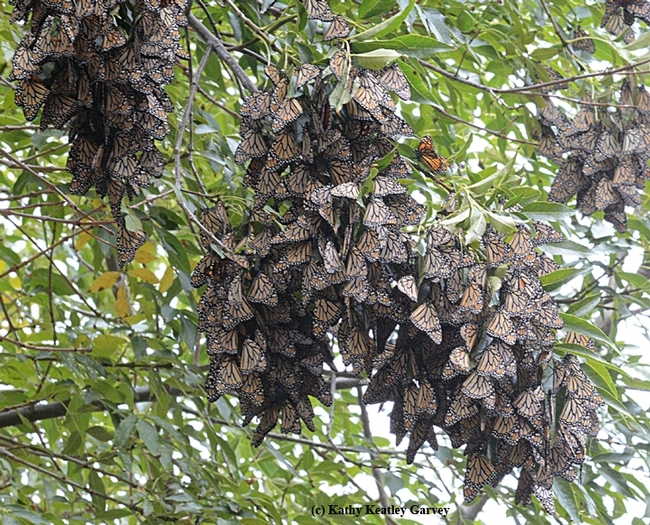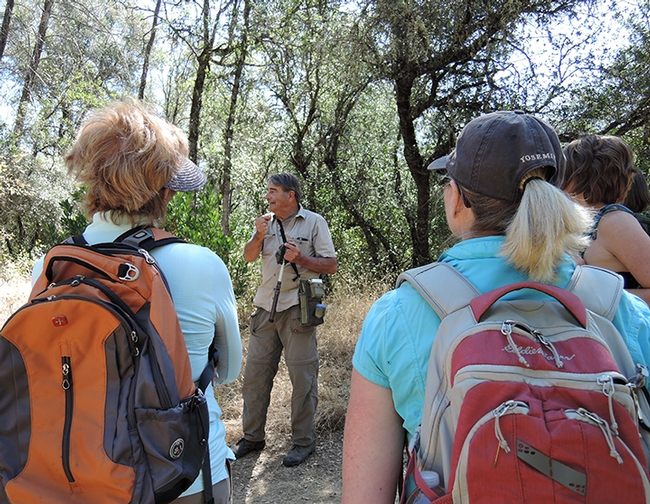
When we drove to Santa Cruz on Dec. 27, 2014 to an overwintering site, we saw a monarch cluster 80 feet up--80 feet up, up and away--in a eucalyptus tree. We never saw a single tag. Then on Nov. 30, 2015 we drove to the Berkeley Aquatic Park to see a monarch cluster, 25 feet high in an ash tree. We never saw a single tag.
So it was really amazing, as recounted in a previous Bug Squad blog, to find and photograph a tagged monarch in our own backyard. The male monarch, tagged monarch@wsu.edu, A6093 and part of entomologist David James' research program at Washington State University, fluttered into our yard in Vacaville, Calif. on Monday, Sept. 5.
We later learned that citizen-scientist Steve Johnson of Ashland, Ore., a member of the Southern Oregon Monarchs Advocates, tagged and released the male monarch on Sunday, Aug. 28. So, the monarch flew 285 miles in seven days or about 40.7 miles per day, James pointed out. And it's one of his earliest recoveries.
But back to sightings of tagged migrating monarchs.
We asked butterfly guru, Art Shapiro, UC Davis distinguished professor of evolution and ecology, how many tagged migrating butterflies he's seen. He's studied the Central California population of butterflies—not just monarchs—for more than four decades, and is out in the field at least 200 days a year. A fellow of the American Association for the Advancement of Science, the Royal Entomological Society and the California Academy of Sciences, Shapiro maintains a website on butterflies at http://butterfly.ucdavis.edu/, where he records the population trends he monitors in Central California. He wrote A Field Guide to Butterflies of the San Francisco Bay and Sacramento Valley Regions, illustrated by artist Tim Manolis and published in 2007 by the University of California Press.
So, how many tagged monarchs has Art Shapiro seen in the field? "I've only seen one tagged one in the past decade--at Gates Canyon (Vacaville)," he said, "but it was too far away to read the tag, alas."
Curious, we asked a few other UC Davis scientists who study monarchs how many they have seen.
- Hugh Dingle, emeritus professor of entomology, none.
- Louie Yang, associate professor of entomology, none.
- Greg Kareofelas, an associate of the Bohart Museum of Entomology, two.
Karefoelas spotted his first tagged monarch on Table Mountain, Butte County “but it was a long time ago," he said. "It was long before I had a digital camera, so no pic."
Kareofelas sighted another tagged monarch at Knights Landing, Yolo County, on April 23, 1997. He found it on his father's ranch on Road 102, just south of Knights Landing. It was a male monarch, with the serial number #58984, tagged Jan. 29, 1997 at an overwintering site in Santa Barbara.
Kareofelas notified research project leader Walter Sakai, a biology professor at Santa Monica College, who thanked him for the find. Where exactly was it tagged? At Santa Barbara's Ellwood Main, located just west of the UC Santa Barbara campus in Goleta. In a letter to Kareofelas, Sakai wrote: “This is the furthest distance a tagged migrating monarch has traveled from our 1996-97 tagging effort. The second furthest was to Groveland near Yosemite. This recovery will be one piece of the puzzle in understanding the spring migration phenomenon of monarch butterflies."
Meanwhile, the Pacific Northwest monarch migration to coastal California continues through the end of October. Keep a lookout for a WSU-tagged monarch. If you find one (and be sure to photograph it, if you can) contact James at monarch@wsu.edu.
Attached Images:

Roosting or overwintering monarchs in the Berkeley Aquatic Park on Nov. 30,2015. No tagged monarchs are visible. (Photo by Kathy Keatley Garvey)

Naturalist Greg Kareofelas (center), an associate with the Bohart Museum of Entomology, has sighted two tagged migrating monarchs, one at Table Mountain and the other at Knights Landing. (Photo by Kathy Keatley Garvey)